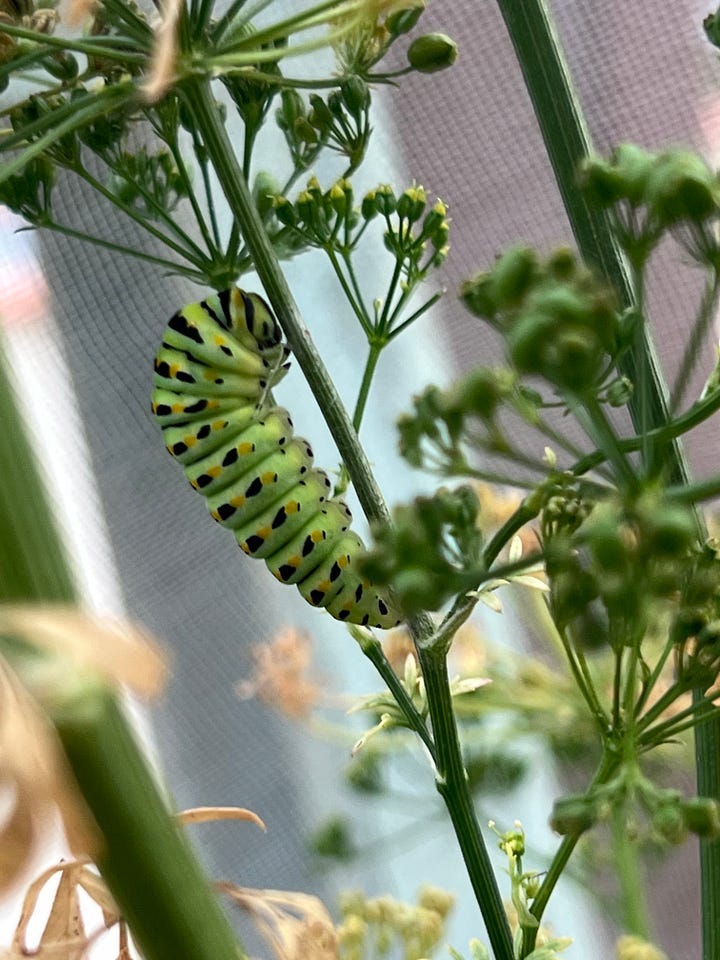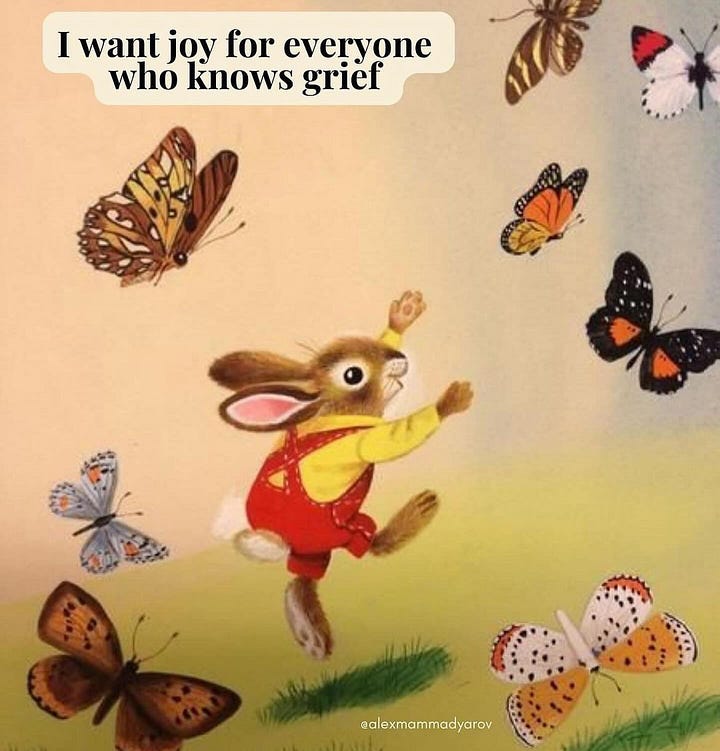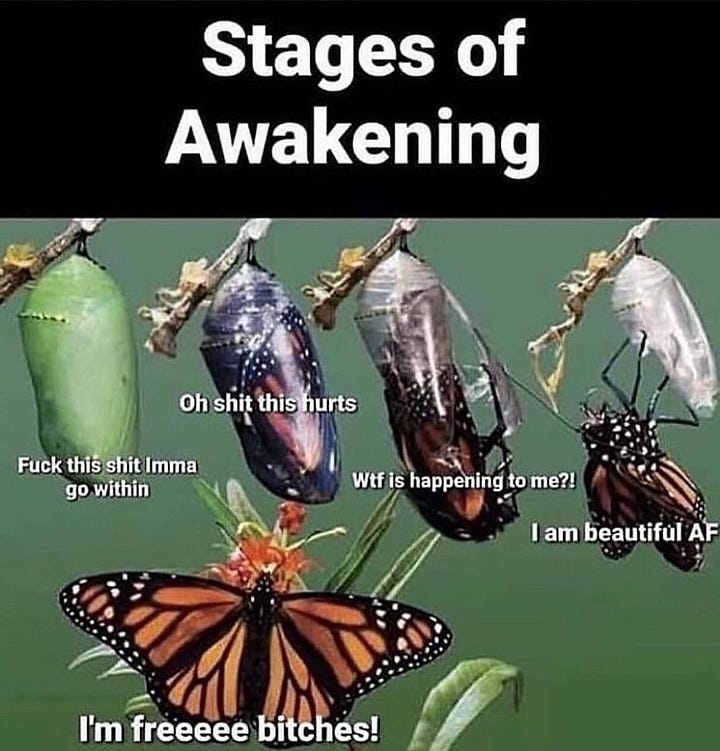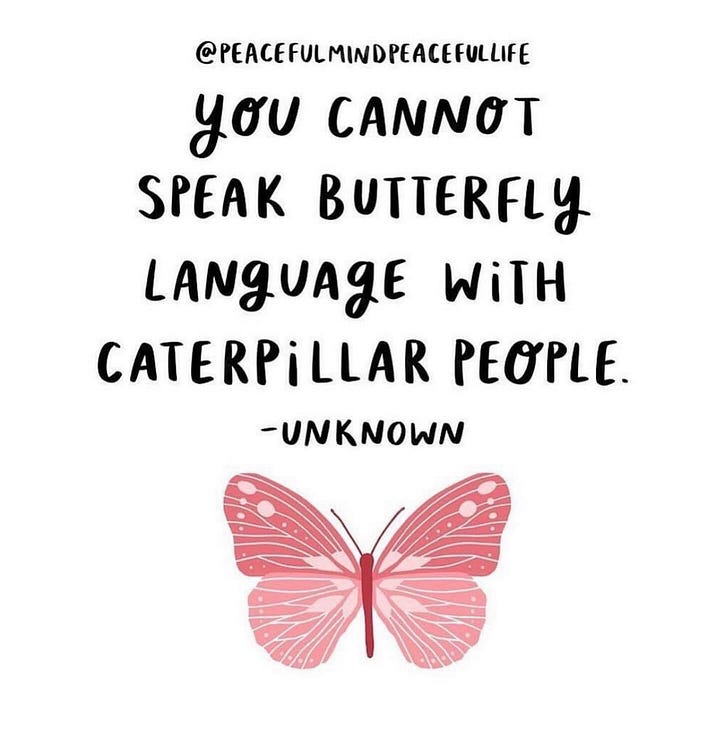On August 29, 2024, I shared reflections on metamorphosis in an Instagram post, expanded on below. In an exciting coincidence, or what we might even call synchronicity, I discovered two swallowtail caterpillars in my garden that very same afternoon—the first time in its four years that my garden held such special visitors!
I watched with childlike curiosity and glee over the next two days as the caterpillars munched away until they became quite plump, absolutely adoring their little booties grasping parsley flowers.
In yet another moment of synchronicity, the first caterpillar entered its chyrsalis on September 2, the very same day that my identical twin sister entered a metamorphic chapter and moved from Los Angeles to France. I, too, have been feeling a pull to make a move, though it has thus far been a subtle shift within me, as if a ship in harbor has lifted its anchor; no discernible movements have been made, yet there is a felt awareness that change is coming.
Seeing my sister off on her flight to France felt as though she is spreading her butterfly wings, whereas I am grasping onto my caterpillar state. The second caterpillar entered its chrysalis three days after her departure.


UPDATE ONE, 9/16/24:
The first baby butterfly has emerged! When I saw her for the first time, I exclaimed, “You bloomed!”
Reflections on Metamorphosis
When I was young, I imagined that a caterpillar enters a cocoon, sprouts wings and antennae onto its caterpillar body, and then poof, magically emerges as a butterfly.
In actuality, the caterpillar dies and dissolves into liquid while forming the chrysalis, and this “caterpillar soup” contains cells known as imaginal discs representing what it will need to become a butterfly (wings, antennae, legs, eyes, etc.). These discs use the liquid they are bathing in to form into an adult butterfly.1
That is, the caterpillar has the makings of the butterfly within itself all along—from the time it was still forming inside an egg—and the caterpillar’s death fuels the butterfly’s rebirth!
In this same way, we carry our deeper purpose and authentic path inscribed within us, a divine unfolding waiting to be activated. While we may mistakenly believe we need to look outside of ourselves for our deeper purpose, it is sitting within us all along. The invitation towards embracing purpose is more of a shedding and excavating to embrace our sacred gifts within, rather than an external hunt.
“We are like Tolstoy’s fabled beggar who spent his life sitting on a pot of gold, begging for pennies from every passerby, unaware that his fortune was right under him the whole time. Your treasure – your perfection – is within you already. But to claim it, you must leave the busy commotion of the mind and abandon the desires of the ego and enter into the silence of the heart.”
―Elizabeth Gilbert,Eat, Pray, Love
Spiritual awakening also similarly feels like a death and is hard and isolating. We are disrupting all we have known, while shedding the layers of socialization, learned behaviors, coping mechanisms, operating systems, and armor that we understandably latched onto as survival mechanisms for most of our lives.
Parts of us must die to make way for our own metamorphosis. When we are on the other side, we can appreciate that those dark nights of the soul reignited our true self and created a blaze within to pursue an authentic, fulfilling, freeing, and homeward bound path.
Yet oh how we resist! We can have an inviting gateway to a higher self standing right in front of us, yet we balk at the perceived risks of changing things up, for our ego and survival strategies are so entrenched in our current caterpillar state, clutching the illusion of comfort in the familiar. And to become a butterfly means a death to those things.
We would sooner cling to a familiar hell than leap into an unknown paradise.
The bittersweet nature of transformation is universal. We often admire people on the other side celebrating a new chapter, yet we do not witness the universal messy middle of the liminal space that got them there.
By honoring the full process, as opposed to just the beautiful butterfly ending, we accept that to reach our highest levels of potential, we too must first suffer a series of losses, deaths, and shedding of our old selves, with our grief enriching the fertile soil from which we bloom.
We learn that our relationship with grief is a sacred pathway towards lasting fulfillment, as our capacity for grief equals our capacity for joy. To hold grief is to carry an awakened, powerful heart. When we meet with compassion the grief in letting go of that which no longer serves us, we make space for a truly transformative next chapter. If we resist grief and ignore the losses, we tend to continue on the same path we have been on, repeating the same caterpillar patterns, never breaking free.
To embrace the full cycle of loss and rebirth, we intuit that out of darkness comes light. And when we find ourselves once again clinging to a familiar shoreline, sensing a kind of death to our present self, we will ultimately trust that a new world beyond our wildest dreams awaits us, if only we are so brave to let go.
UPDATED 9/17/24: Thank you to Simon Spire, who shared the following with me:
When the caterpillar enters his silk cocoon (for him, a tomb), he dies to his previous life and enters a liminal time of being neither Earth-crawling worm nor wind-borne flier. Within his cocoon, the caterpillar pupa, the chrysalis, does not feed; within ours we do not draw further sustenance from society. The Cocoon results in the disintegration of almost everything we know about the world and ourselves. Upon emerging from the cocoon, the individual is reborn as a true adult. The butterfly, of course, understands this.
Inside the caterpillar’s body are clusters of cells called imaginal buds which contain the blueprint for growing the butterfly. While the caterpillar goes through its Earth-bound business, these cells, hidden inside, are imagining flight.
The caterpillar’s immune system believes these imaginal cells are foreign and tries to destroy them, not unlike the way uninitiated human egos and egocentric culture try to destroy the soul, nature, and the feminine. It’s as if the caterpillar doesn’t realize its destiny is to become a butterfly. Likewise, the uninitiated ego doesn’t realize its destiny is to become an agent for soul.
Once in the cocoon, the buds link up, the caterpillar’s immune system breaks down, and its body literally disintegrates. The buds then build a butterfly from the chrysalis fluids.
What triggers the caterpillar’s cocooning? During the larva stage, the caterpillar goes through four or five molts, each time shedding its skin for a new suit. But finally it gets to the skin that will not molt because biological sensors have detected that the skin has stretched as far as it is designed to go. This prompts the cocooning. It’s as if the caterpillar knows in this moment that this is the end of the line for its old strategy of personal growth.
We humans go through several molts before the Cocoon—when the personality finally loses its grip. These molts include Birth, Naming, and Puberty, and perhaps others. Confirmation signals that the first personality has taken us as far as it can.
Bill Plotkin, https://www.animas.org/about-us/our-founder/




See Scientific American article for more on metamorphosis and this video that captures a swallowtail caterpillar to chrysalis!





Such incredible heart felt writing. Thank you for sharing your gifts with the World Gena. ❤️
Love this read and sending love to you ❤️